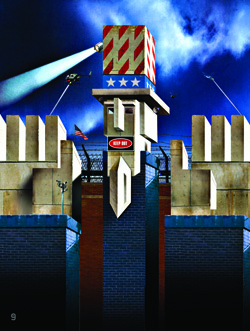Prison Break: Budget Crises Drive Reform, But Private Jails Press On

Illustration by Eddie Guy
Some saw deviltry in the details of a letter (PDF) the Corrections Corporation of America sent to the heads of state corrections departments in January, offering to buy prisons rather than run them for hire.
Just two weeks earlier, the CCA—the largest company in the nation’s private prison industry—had made the first-ever outright purchase of a state penitentiary. Now it wanted more, striking while the leg-iron was hot. Until that sale, for more than three decades various for-profit incarceration businesses had only contracted to run state and local lockups or built new private ones themselves. The CCA poured $72.7 million into Ohio’s cash-starved coffers to buy the Lake Erie Correctional Institution.
Then the CCA dangled $250 million in front of officials in other states agonizing over how to squeeze dollars from dirt in a down economy. In return for sacks of cash, the company wants 20- to 30-year contracts for housing criminals. And the already controversial full privatization also requires states to grind out convictions and sentences for two or three decades at today’s pace and severity, maintaining a guaranteed 90 percent occupancy rate—calibrating the wheels of justice to fit a profit-margin spreadsheet.
But that near-no-vacancy sign might prove difficult to lock in. In each of the past three years, overall population in state prisons has declined a bit—dropping for the first time since 1972, when tough-on-crime policies gained traction. Some states are closing prisons, while others have decided not to build facilities already planned.
That is largely because more and more states are seeking alternatives to what had become lock ’em up and throw open the wallet. They are finding some early success. “Back in the 1980s, we couldn’t talk about criminal justice without mentioning the broken-windows theory, and now that’s happening with mass incarceration,” says Todd Clear, dean of the School of Criminal Justice at Rutgers University. “It’s not just the research and findings, but the fact that the discussion is happening. Something fundamental has changed.”
Where two or more decades of ethical, moral and evidence-based reasoning failed, pinched purses of the public fisc are driving change. The states spend more than $50 billion a year on corrections, according to the Pew Center on the States. Now they’re being forced to get smart on crime. Simply being tough is a luxury.
The U.S., which puts a greater percentage of its citizens behind bars than do China, Russia, Iran and others considered draconian when it comes to criminal justice, might even lose its perch as the world’s leader at incarceration. Not only do we incarcerate more of our citizens; they’re staying in longer. Prisoners released in 2009 had spent an average of nine months longer behind bars than those let out in 1990, according to a study by the Pew Public Safety Performance Project (PDF). “Some nonviolent offenders serve 40 or more years,” Clear says. “That’s insane.”
Click here to read the rest of “Prison Break” from the October issue of the ABA Journal.



